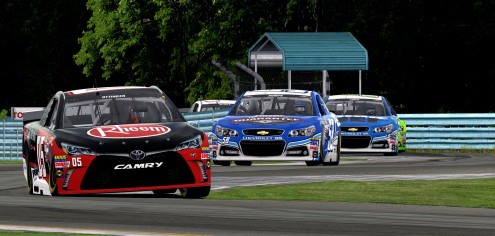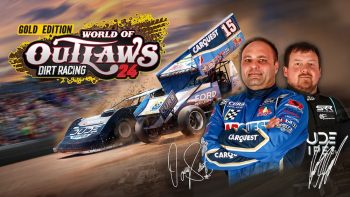
Behind the Scenes: The NASCAR Peak Antifreeze Series powered by iRacing.com – The Science of Strategy
August 26th, 2015 by Jaime Baker
The race was only 50 laps, we could run 27 laps on one tank of gas. But to make it complicated, so could everyone else. There was no chance of any driver making two stops, no chance of the usual trickery that can play out during a 200-lap race to shuffle up the leader board and put some cars off sequence and later pin them into a spot out of contention. Only sixteen races will be run during the 2015 NASCAR PEAK Antifreeze Series, and Watkins Glen was, and will be, the only race of the year where fuel mileage considerations were an impossibility. Raw speed was king, so ensuring the speed was always present was exactly what was needed. I’m going to go into the process of how we developed the strategies to win both Indianapolis and Watkins Glen, so math will take place here. As Destin Sandlin from Smarter Every Day says, “Goggle up, science is about to happen.”
I’m sure the race two weeks ago at Watkins Glen looked pretty simple at the front of the field. Nick Ottinger and Kenny Humpe just drove around the track 50 times. The back of the field was nighmarish, with cars losing front ends, rear ends, and achieving camber values that had previously been unattainable. One of the most difficult things to do in racing is be in the lead, mainly because whoever is in second place is controlling the leader’s strategy in most cases. Since he stayed within a few seconds of Nick during the entire race, Kenny was in a prime spot to pit at just the right moment and flip the race. I had the strategy for Watkins Glen planned a few days ahead of the race, identifying the lap after which the pit stop would take place, and actually having a pace that Nick needed to run in order for the strategy to work. Kenny actually did pit when I expected, and he very nearly slotted into the lead during the pit sequence.
With tire falloff, aero issues in traffic, and the coming “dynamic tracks,” it’s going to be important to have strategies ready to go ahead of the race. Watkins Glen was only one pit stop, so where’s the strategy? It’s more complicated than you’d think, and it came from studying strategies from Formula 1, Le Mans, and especially that 2011 race at Sonoma where Kurt Busch waxed the field. We do have only 50 laps, but we need those 50 laps to be as fast as possible. Put simply, the race can be expressed by a single “starter” equation:
50 Laps + 1 Pit Stop = 1 Race
You can even apply this to other races by changing the numbers, but it’s all the same. When we express it as time, it becomes:
50*(Average Lap Time) + Time on Pit Road = Race Total
From this, we know that the race total is dependent on the stuff during the race. Duh. Hopefully you knew that. Individual lap times are irrelevant, we need an average that’s good. Since the average is multiplied by 50, it’s hugely important. As for the time on pit road, we only had one trip there, and it’s basically the same for everyone, right around 43.5 seconds from the entry cones to the exit cones. Since pit speed is mandated, we have no control over that, and the only variable is based on the randomness of the pit stop timer. This leaves us with just the average lap.

Even though he only visited us once, it was crucial for Nick to spend as little time on pit road as possible. Thus, an empty pit road was ideal.
Average lap times are very hard to pin down, and even the best drivers in the world sometimes struggle to manage their lap times with great accuracy. In the case of road racing, we know a few simple things that can affect the average lap time: 1) times will increase if tires wear too much, and 2) times will drop if the car loses weight to fuel burnoff. These are given facts that are simple, but combining them causes major issues. If the tires lose grip too fast, either by wear or excessive heat buildup, and the fuel doesn’t burn off quick enough to lighten the car to keep the tires adhering to the road, the car will lose a lot of time per lap from sliding. Once this begins, it compounds into something that is unrecoverable until pitting. So we need the driver to slow down right? Not exactly! If the driver goes slow enough to mitigate tire issues, he runs the risk of the tires becoming too cold and losing the ability to grip the road. Plus, he likely didn’t burn up enough fuel to match, and now the car is too heavy with no grip instead of being too light with melted tires. Both are disastrous.
It’s for this reason we see a lot of the things in racing that fans hate. In the 24 Hours of Le Mans, it’s not uncommon for leading P1 cars to be told, “Your pace is too fast, slow down” only 13 or 14 hours into the race. They need to make it to the next stop with [this much fuel] and [this much left on the tires] for their strategy to work. Similarly, we see this in oval racing. The more experienced drivers may carve their way through the pack and make up 10 or so positions, then seem to stall in second place about one or two seconds behind the leader. True, there are likely some aero problems involved, but if the race is in the middle stages, there’s no point in passing the leader. Sitting in second place running a pace that is below what he’s capable of helps a driver manage tires and fuel, and hopefully the leader wastes his equipment, eventually dropping him from contention late in the race.
This is what the three of us, Nick, Peter Fisher (our spotter), and myself, had to do during the Watkins Glen race. The car was perfect for Nick’s driving style, and was easily capable of running much faster than he showed. As a matter of fact, he was so calm during the race that he kept asking what Peter was drinking when we heard the clinks of ice cubes over his microphone. We discussed it prior to the race, and knew that we needed to go at least halfway before ever pitting. Real-world teams, for some crazy reason, work the races backwards. This has become so widely accepted that every team does it without thinking of other possibilities, which is why Kurt Busch’s win at Sonoma was so mind-boggling. They didn’t run the race backwards and walked off with the win.
“This has become so widely accepted that every team does it without thinking of other possibilities, which is why Kurt Busch’s win at Sonoma was so mind-boggling.”
Personally, I hate the “backwards” racing and avoid it if possible. For one, it locks the driver into a pace for the entire fuel run. He cannot increase his pace beyond a certain point, otherwise he’ll run out of gas with a lap or two to go. Similarly, running the entire fuel run pushes the tires into the red area, and every single run will end with a sharp falloff. While this seems to be accepted in NASCAR road racing, this is avoided at all costs in other forms of racing. Formula 1 teams have been known to add a pit stop to a race to avoid the sharp falloff (known as a performance “cliff” due to the shape of the tire’s performance graph) and keep the car moving quickly at all times.
Since we would only make one stop anyway, we used the Formula 1 method for Nick’s race. We knew that he could run 27 laps at a pace of 1:09.8, so our pit window opened on Lap 23. However, if he ran the entire 27 laps on a tank, he could go no faster than 1:09.8, otherwise he’d run out at the end. Plus, in the closing laps, his pace would likely fall off into the mid 1:10s due to tire degradation. Instead, we elected to push a few laps onward, to halfway, where the laps from 22 to 25 would be still in the 1:09s if needed. This eliminated laps at the end of the race being slower, and reduced the overall average lap time from the race by only a few hundredths of a second . . . but over 50 laps that resulted in a half-second or so that we banked for later. The pit cycles began on Lap 22, as expected, but we pitted on Lap 26, one of the last of the entire field. This put our second stint at only 23 laps, allowing the required pace to drop, since we now had four extra laps of gas in the tank. Plus, since the tires only needed to go 23 laps instead of 27 or 28, Nick could push harder if needed.

Traffic results in a slower pace, so it was crucial to make sure the gap to second increased before dealing with the traffic to prevent any attacks.
Contrary to what everyone has thought, there were periods during the race when Kenny did turn a few laps, in succession, that were a few tenths faster than Nick’s laps. This caused the strategy to move from concrete to fluid in response to Kenny’s challenge for the lead. If Kenny’s pace fell, I told Nick by how much, and he reduced his speed. If Kenny picked it up, Nick shaved that much off his own lap to match. This call-and-answer system is seen widely in most upper-tier long-distance racing in an effort to manage what the driver has “in reserve,” giving a chance to respond to challenges. Aside from endurance racing, there’s often no benefit to having an eight second lead instead of a four second lead. Drivers often lead by a comfortable gap and maintain it, only changing their own pace to accommodate incoming problems such as lapped traffic. We see it constantly in Formula 1, and I’ve even done it in kart racing when I knew my current position could not be bettered before the end of the race.
We used a similar strategy to this at Indianapolis, yet on a much more complicated and grand scale. Plus, we were not in the optimum position during the Indianapolis race and had to respond instead of calling what we wanted. We’re lucky right now since the tracks don’t actually change during the race, but when they start becoming their own living entity, strategy will be even more important and will bleed down into other series besides the NASCAR PEAK Antifreeze Series and the iRacing Grand Prix World Championship. Maybe not so much into the Legends series, but it’s very possible that the teams who manage their equipment and strategy the best in the Class C trucks can become kings of sim racing in the future.

















































